Building a Better Honeybee
Air Date: Week of November 13, 2015
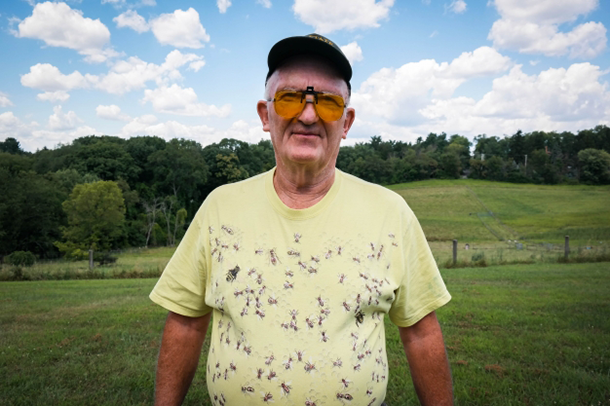
Terry Shanor, a beekeeper from Butler County, sports his favorite shirt at the annual picnic of the Pennsylvania State Beekepers Association. A co-op of beekeepers in the region are trying to breed tougher honeybees that can survive cold winters and fight back against parasitic mites. (Photo: Lou Blouin)
Bees are vital for our food system because they pollinate so many fruits and vegetables, but disease, pests and new insecticides have hit them hard. So a group of beekeepers and researchers are breeding a honeybee that can better resist destructive mites that weaken colonies. Lou Blouin of the Allegheny Front reports.
Transcript
CURWOOD: It's Living on Earth, I'm Steve Curwood. Fall can be an exciting time of year for beekeepers. Despite the problems plaguing bees - disease, pesticides and this year a drought that’s reduced the honey flow in parts of the country, it’s still the time when bee-wranglers see the results of their and their bees work. We have a resident beekeeper right here at Living on Earth, Helen Palmer and she’s been busy as that proverbial bee.
[SPINNING OF HONEY EXTRACTOR]
PALMER: Now that’s a familiar sound to beekeepers like me, who have only one or two hives – it’s the noise of the extractor. It’s a centrifuge to get the honey out of the combs where the bees carefully store it. What we do is open up the hive and take the frames full of honey.
[BUZZING OF BEES]
PALMER: The bees aren’t too keen on that, so we puff lots of smoke at them.
[SOUNDS OF PUFFING SMOKE]
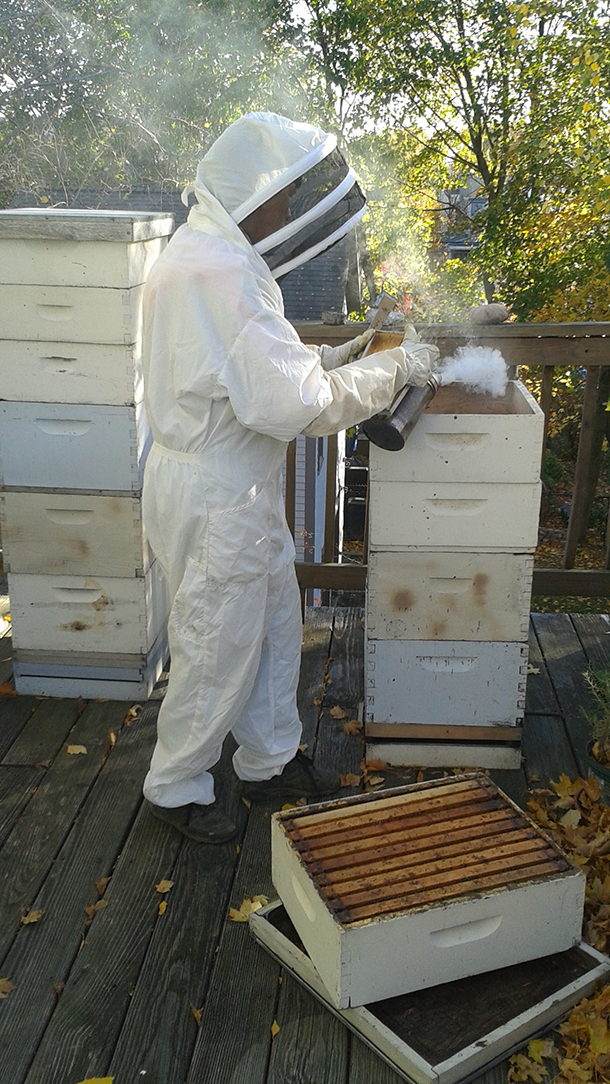
Living on Earth's Helen Palmer, a keen beekeeper, calms her bees with smoke before extracting this fall's batch of honey. (Photo: courtesy of Helen Palmer)
PALMER: Then we carefully cut the wax capping off the combs and put two or three inside the extractor and spin it, and the honey flies out.
[EXTRACTOR SPINNING]
CURWOOD: Yes, but, Helen, the proof of the pudding is in the eating. So where’s the honey for me to taste?
PALMER: Well it just so happens I do have one of my few precious jars of honey here. You can only have a smidgen though!
[SFX OPENING JAR, SPOON]
CURWOOD: Mmmm...wow that is really good. Thank you, Helen.
PALMER: You’re welcome, Steve.
CURWOOD: And you will be back in a few minutes with news of beekeeping from thousands of years ago, but meantime, we have a story from Lou Blouin of Pennsylvania Public Radio’s Allegheny Front. He has an update about one of the biggest problems facing bees in recent years – a pest that weakens hives and how researchers and backyard beekeepers are teaming up to build a better honeybee.
BLOUIN: Beekeepers have plenty of tough days. But this—this is a good day.
RAPASKI: [CHEWING] My mouth is full. We’re eating honey that is fresh from the hive. And it’s so delicious.
BLOUIN: That's Pittsburgh beekeeper Steve Rapaski. And he actually hasn’t been around to check on this particular hive in a month. And now, the bees, have built a crazy jagged, mini mountain range of foot-tall honeycomb inside an empty bee box...
RAPASKI: The good news is that it’s what we call fresh cut-comb honey. But it’s what we call a major screw-up by a beekeeper that should have put frames in there a month ago.
BLOUIN: As far as screw-ups go, it’s not really a big deal. But beekeepers aren't really allowed a whole lot of real screw-ups. And not because of colony collapse disorder. Scientists actually don’t really see much of that these days. Bee researcher Maryann Frazier says the main thing that’s been wiping out honeybees since 1990s is actually a parasite, called the varroa mite.
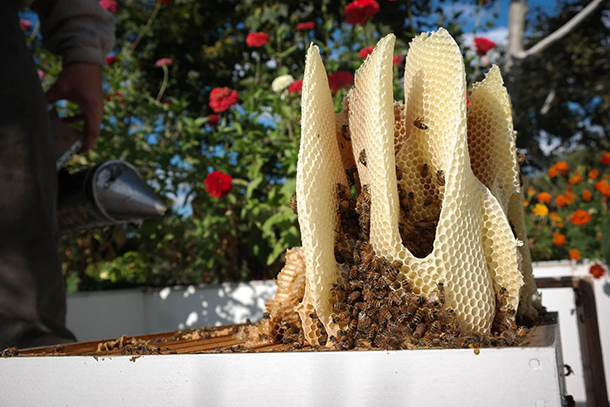
Typically, beekeepers insert rectangular wooden frames into bee hives so that bees will store honeycomb neatly inside the hive. As urban beekeeper Steve Repasky found out, this is what happens when you forget the frames: The bees will build a free-form comb inside the empty box, much like they would do in the wild in hollow trees. (Photo: Lou Blouin)
FRAZIER: It’s a parasitic mite that feeds on blood of adult bees and on the brood.
BLOUIN: And it’s basically like having a six-pound house cat attached to your side, sucking the life out of you. Treatments for these mites were, and still are, pretty limited. Get this: We actually spray bees—which are, of course, insects—with insecticides. The hope is we’ll kill the mites, but not the bees. The approach has worked well enough to at least give colonies a fighting chance. But out on a farm in western Pennsylvania, beekeepers are trying a new approach.
[FOOTSTEPS IN GRASS]
BERTA: Let’s go light a smoker and look at some bees.
BLOUIN: This is commercial bee breeder Jeff Berta. He’s part of a co-op of about 100 beekeepers stretching from Michigan to Tennessee that’s trying to build a better honeybee.
BERTA: Number 18, she is there. That little disc there with the 18 on it, we call those our Nascar bees because they have numbers on them.
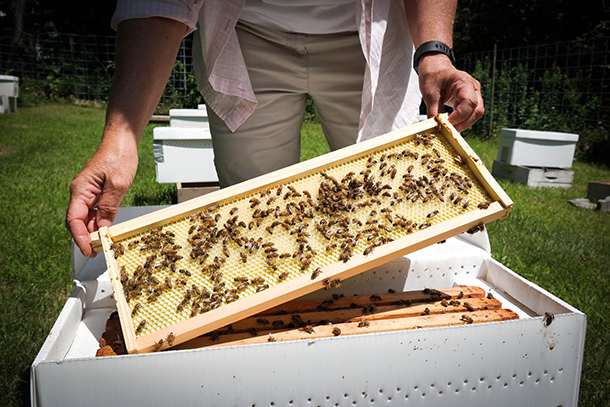
Maryann Frazier, a researcher at Penn State's Center for Pollinator Research, checks on one of her experimental honeybee hives. Frazier is testing the effects of pesticides on honeybee colonies. (Photo: Lou Blouin)
BLOUIN: Number 18 is one of Berta’s all-star queen bees. She’s also a bit of a science experiment. This queen’s mother is from a Vermont colony that survived disease and cold winters. And then Berta had her artificially inseminated by Purdue University scientists, who developed bees with natural resistance to mites.
BERTA: The bees will take the mite and they will bite the legs and will chew on the mite. And if they bite a leg off of the mite, the mite will bleed to death. So the bees are actually fighting back. That’s the type of genetic line that we’re after right now.
BLOUIN: So now with every egg No. 18 lays, she passes on those leg-biting behaviors—making a colony that can rid itself of mites naturally, with no help from pesticides. It’s a huge breakthrough. But the breeding project can’t end there. Because Berta can’t artificially inseminate every queen, any descendants of No.18 that turn into queens themselves will likely just fly off and mate with any old drones within a few miles. Meaning, if Berta’s beekeeping neighbors don’t have strong bees too, they can easily dilute his carefully selected lines. Bee geneticist Christina Grozinger says you have to be in it for the long haul.
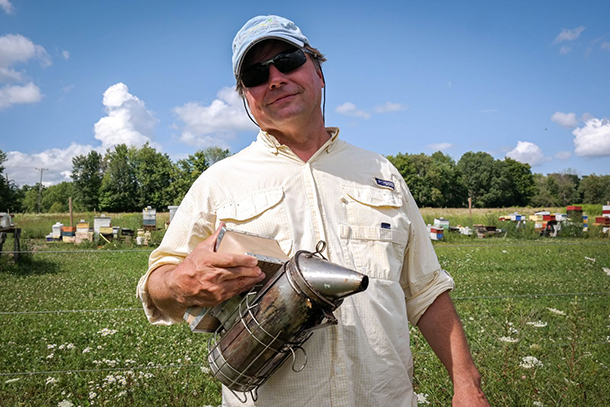
Bucking the paradigm in the beekeeping world, beekeeper and breeder Jeff Berta doesn't use pesticides to control mites on his honeybee colonies near Slippery Rock, Pennsylvania. Instead, he breeds bees that have natural grooming behaviors that keep colonies free of mites. (Photo: Lou Blouin)
GROZINGER: So, you can’t sort of produce a stock and say, Now I’m done! And that was it! Now we can just sell it everywhere! You have to constantly reselect and constantly have to have people very interested in working as part of this effort.
BLOUIN: That’s why Jeff Berta and the co-op of beekeepers happily give eggs from their best colonies to neighbors and swap queens to try out new genetics. It’s all part of shifting the paradigm from a system where beekeepers simply buy new bees every year, to a lasting neighborhood of bees that can slowly create real survivors. I’m Lou Blouin.
CURWOOD: Lou Blouin reports for the Allegheny Front.
Links
More about the honeybee and colony collapse disorder
The varroa mite and its viruses plague honeybees
Finding honeybee behavioral genes that help bees fight mites
Continual selective breeding and research may help build a mite-resistant bee
Living on Earth wants to hear from you!
Living on Earth
62 Calef Highway, Suite 212
Lee, NH 03861
Telephone: 617-287-4121
E-mail: comments@loe.org
Newsletter [Click here]
Donate to Living on Earth!
Living on Earth is an independent media program and relies entirely on contributions from listeners and institutions supporting public service. Please donate now to preserve an independent environmental voice.
NewsletterLiving on Earth offers a weekly delivery of the show's rundown to your mailbox. Sign up for our newsletter today!
 Sailors For The Sea: Be the change you want to sea.
Sailors For The Sea: Be the change you want to sea.
 Creating positive outcomes for future generations.
Creating positive outcomes for future generations.
 Innovating to make the world a better, more sustainable place to live. Listen to the race to 9 billion
Innovating to make the world a better, more sustainable place to live. Listen to the race to 9 billion
 The Grantham Foundation for the Protection of the Environment: Committed to protecting and improving the health of the global environment.
The Grantham Foundation for the Protection of the Environment: Committed to protecting and improving the health of the global environment.
 Contribute to Living on Earth and receive, as our gift to you, an archival print of one of Mark Seth Lender's extraordinary wildlife photographs. Follow the link to see Mark's current collection of photographs.
Contribute to Living on Earth and receive, as our gift to you, an archival print of one of Mark Seth Lender's extraordinary wildlife photographs. Follow the link to see Mark's current collection of photographs.
 Buy a signed copy of Mark Seth Lender's book Smeagull the Seagull & support Living on Earth
Buy a signed copy of Mark Seth Lender's book Smeagull the Seagull & support Living on Earth

